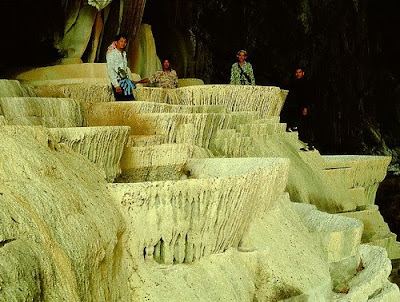

Kanchanaburi, which has mostly mountainous terrain, covers an area of approximately 19,483.2 square kilometers and is the third largest province in Thailand after Nakhon Ratchasima and Ching Mai. Situated approximately 129 kilometers west of Bangkok, Kanchanaburi shares a borer with Myanmar to the west,Tak and Uthai Thani Provinces to the north, Suphan Buri Nakhon Pathom Provinces to the east, and Ratchaburi Province to the south.
In north and west Kanchanaburi, the terrain is comprised mainly of mountains and high plains, with the Thanon Thongchai Range acting as a natural border between Thailand and Myanmar. The range is the source of Kanchanaburi’s two most important rivers Kwae Noi River and Kwae Yai River, which form the famous Mae Klong River. As a result, several of Thailand’s largest waterfalls and most extensive wildlife sanctuaries are found in this area.
The magnificent landscape and charming beauty of Kanchanaburi have resulted in major tourist attractions including several well-known waterfalls, caves which were once inhabited by Neolithic man, pristine national parks, tranquil rivers, virgin forests, and reservoir. Together, they offer an intriguing experience for first time or repeat visitors. Whether it’s fishing, canoeing, mountain biking, bird-watching, star-gazing, golfing, elephant and jungle trekking, or even The city of Kanchanaburi is located at the point where two tributaries, the Kwae Noi River and Kwae Yai River meet and form the Mae Klong River. This is the location of the notorious Death Railway and the Bridge over the River Kwae-one of the world’s famous World War II sites which have been immortalized in print and film.
Residents of Kanchanaburi are engaged in agricultural activities. Most of the locals are of Thai ancestry with notable Mon and Karen minorities. Rural dwellers enjoy living simply and respecting nature.
kanchanaburi Administration comprises 13 districts (Amphoe) and the distances from Amphoe Muenge (Kanchanaburi Town) to Neighboring Districts :
Town -> Saiyok 50 km. Town -> Lao Khwan 98 km.
Town -> Thong Pha Phum 145 km. Town -> Huai Krachao 60 km.
Town -> Sangkhla Buri 215 km. Town -> Phanom Thuan 24 km.
Town -> Si Sawat 130 km. Town -> Tha Muang 13 km.
Town -> Bo Phloi 45 km. Town -> Tha Maka 30 km.
Town -> Nong Prue 75 km. Town -> Dan Makham Tia 30 km.
By car from Bangkok
Route 1: a 1.5 hour drive along Highway No.4 (Phetkasem Road) and Highway No.323 via Nakhon Chaisi Province. Nakhon Pathom Province,Ban Pong (in area of Ratchanuri Province) Tha Maka Tha Muang to Kanchanburi.
Route 2: drive along Highway No.338 from Bangkok to Nakhon Prathom Province then switch to Highway No.4 and Highway No.233 to Kanchanaburi.










































